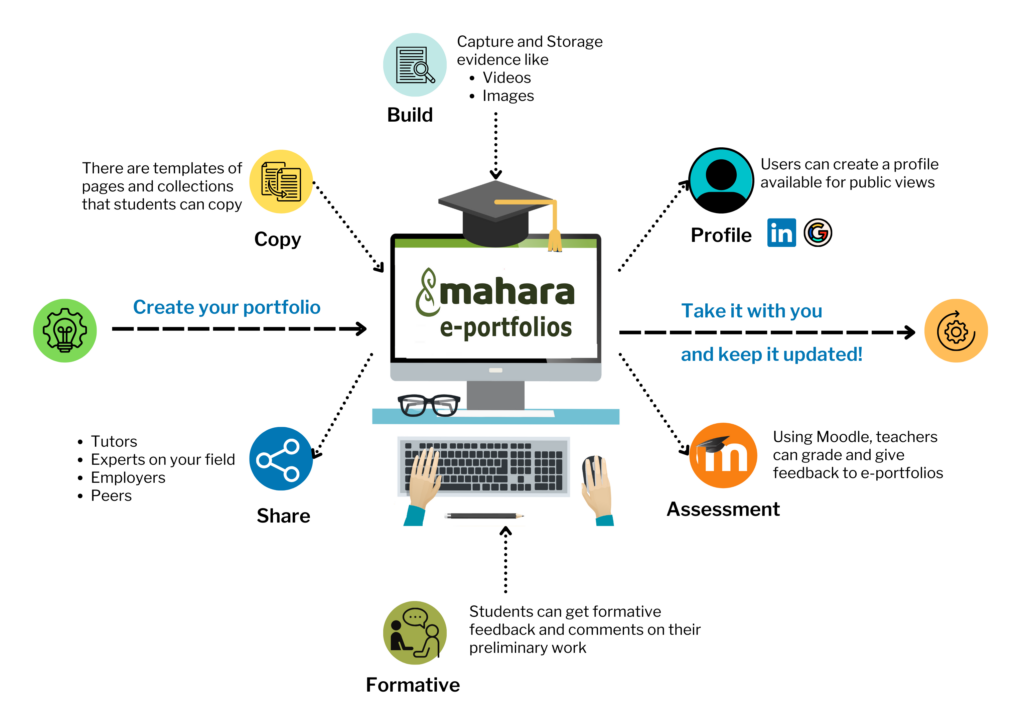Pre-planning for Mahara
Mahara will be an unfamiliar tool for students, and they will need an induction and training in how to use the platform effectively. Staff can use the information here to support this. As with all learning technologies it is also important that staff are confident in using it, both for ‘teaching’ aspects and for supporting students. Please contact tel@bath.ac.uk to discuss your e-portfolio plans, as the team can help support, train and advise you.
e-portfolio technology
Mahara is an e-portfolio platform, where students can record “evidence of learning” such as essays, reports, reflective commentary, task lists, multi-media or artwork (i.e. anything that can be produced and stored digitally). These digital items are known as artefacts in Mahara.
Mahara provides ways for students to interact with their tutors and peers and create online communities. Mahara also includes blogging (through journals) and a résumé (or CV) builder.
An e-portfolio can be used for personal reflection and development and to provide assessment evidence for a course. Students decide what to share with tutor or peers. They can also make a portfolio, or parts of it, public. This can showcase development and achievements to prospective or placement employers.
The word ‘mahara’ is from Te Reo Māori meaning “to think, thinking, thought”. As Mahara was created in New Zealand, it is a fitting Māori word to signify the concept of the e-portfolio system.

Types of e-portfolios
Some types of activities which take advantage of the affordances of e-portfolio software are:
Learning journals which encourage an ongoing personal connection with learning and link theory to practice in relation to the students’ knowledge and experience. This type of assignment helps develop the reflective practice necessary in many professions.
Field work / placement reports – such as placements in a relevant workplace – these provide a rich source of learning in an authentic context and an e-portfolio provides a useful way of gathering a range of evidence which shows what learning has occurred during the placement.
Resource portfolios – these are collections of a range of digital media resources found on the internet. Resources may be focussed on an issue or learning area, with evaluations of the efficacy of the resources and (if appropriate) examples of their use in an authentic context.
Group work assignments involving collaborative learning and critical evaluation, with tasks allocated for each group member requiring discussion and consultation before a final ‘product’ using a range of text items and other media is submitted.
Problem-solving assignments – these focus on an issue or challenge relevant to the field of knowledge and allow the student to suggest multiple solutions, evaluate solutions and recommend and justify a particular optimal solution for the problem.
E-portfolios are often used to give students a platform to develop reflective writing skills. Reflection is …
- thoughts and feelings about experiences, events, ideas, opinions or new information
- a way to develop self-knowledge
- a way to achieve better understanding of why and how things happen
Students can view this University resource on Reflective Writing. It can help them develop the skills they need as a reflective practitioner and improve how they communicate reflections through writing.
How is Mahara different to Moodle?
Mahara allows students to create a digital portfolio. They are in control of the content they create, deciding what to share and who to share it with. Tutors will only be able to view a student portfolio if given specific access.
Staff can support students using copiable templates or by providing an evidence framework. See guides for further details.